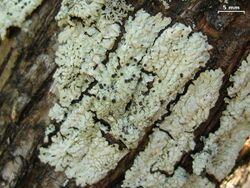Biology:Pyxine cocoes
| Pyxine cocoes | |
|---|---|

| |
| Scientific classification | |
| Domain: | Eukaryota |
| Kingdom: | Fungi |
| Division: | Ascomycota |
| Class: | Lecanoromycetes |
| Order: | Caliciales |
| Family: | Caliciaceae |
| Genus: | Pyxine |
| Species: | P. cocoes
|
| Binomial name | |
| Pyxine cocoes (Sw.) Nyl. (1857)
| |
| Synonyms[1] | |
| |
Pyxine cocoes, commonly known as the buttoned rosette lichen,[2] is a widely distributed species of foliose lichen in the family Caliciaceae.
Taxonomy
It was first described as a new species by Swedish botanist Olof Swartz in 1788. He called it Lichen cocoës,[3] following the lead of Carl Linnaeus who, in his influential 1753 work Species Plantarum, placed all lichens in the eponymous genus Lichen. Finnish lichenologist William Nylander transferred it to the genus Pyxine in 1853.[4] It is commonly known as the buttoned rosette lichen in North America.[2]
Description
Pyxine cocoes has a pale grayish-green thallus comprising radiating lobes that are typically less than 1 mm wide. These lobes are closely attached to the surface of the substrate, have granular soredia that protrude through the cortex in irregularly shaped regions called soralia. The medulla is white, while the apothecia are black with black margins in mature specimens.[2] They are 1–5 mm wide, flat, and disc-shaped.[5] The tissue making up the base of the apothecia is brownish red.[2] Ascospores measure 15–22 by 6–8 μm.[5] The lichen contains lichexanthone, a xanthone compound that is found in about 20 Pyxine species.[6]
Habitat and distribution
Pyxine cocoes grows on bark and rocks.[5] The lichen has been reported from Asia (Japan and the Philippines), East Africa, North America, Central America, and South America, Hawaii, and Australia. In Australia, it is present only in coastal locations that are seasonally humid, and both wet and warm. In this continent, it is common on tree trunks growing on coral cays; these trunks are often used as bird perches, which accumulate bird droppings. Lichenologist Roderick W. Rogers suggests that the lichen could be nitrophilic, which would explain this growth habitat, as well as its tendency to prefer habitats that are at least partially urbanized.[5] In North America, it distribution extends as far north to Florida in the United States.[2]
Biomonitoring studies
Studies conducted in India suggest that Pyxine cocoes is a candidate for biomonitoring of local air pollution.[7] It bioaccumulates toxic heavy metals that it acquires from the air and retains the pollutants in the thallus, which can then be sampled and assayed to determine their concentration.[8][9][10]
Human uses
Pyxine cocoes is used in Papua New Guinea as a component of a traditional medicine-based remedy for inflammatory conditions. In a chemical analysis of the lichen, the triterpene compound 6,22-hopanediol was identified.[11] This compound, commonly known as zeorin, is a hopanoid with potent inhibitory activity against the enzyme protein tyrosine phosphatase.[12]
References
- ↑ "Synonymy: Pyxine cocoes (Sw.) Nyl. [as 'cocoës'"]. Species Fungorum. http://www.speciesfungorum.org/Names/SynSpecies.asp?RecordID=627760.
- ↑ 2.0 2.1 2.2 2.3 2.4 Brodo, Irwin M.; Sharnoff, Sylvia Duran; Sharnoff, Stephen (2001). Lichens of North America. Yale University Press. p. 616. ISBN 978-0300082494.
- ↑ Swartz, O.P. (1788) (in la). Nova genera et species Plantarum seu prodromus descriptioneum vegetabilium maximam parte incognitorum qua sub itinere in Indiam Occidentalem annis 1783-1787 digessit Olof Swartz M.D.. Stockholm: Acad. M. Swederi. p. 146. https://www.biodiversitylibrary.org/page/376865.
- ↑ Nylander, W. (1857). "Enumération générale de lichens, avec l'indication sommaire de leur distribution géographique" (in fr). Mémoires de la Société Impériale des Sciences Naturelles de Cherbourg 5: 85–146. https://www.biodiversitylibrary.org/page/12327973.
- ↑ 5.0 5.1 5.2 5.3 Rogers, R.W. (1986). "The genus Pyxine (Physciaceae, Lichenized Ascomycetes) in Australia". Australian Journal of Botany 34 (2): 131–154. doi:10.1071/BT9860131.
- ↑ Aptroot, André; Jungbluth, Patrícia; Cáceres, Marcela E.S. (2014). "A world key to the species of Pyxine with lichexanthone, with a new species from Brazil". The Lichenologist 46 (5): 669–672. doi:10.1017/s0024282914000231.
- ↑ Bajpai, Rajesh; Upreti, Dalip K.; Nayaka, S.; Kumari, B. (2010). "Biodiversity, bioaccumulation and physiological changes in lichens growing in the vicinity of coal-based thermal power plant of Raebareli district, north India". Journal of Hazardous Materials 174 (1–3): 429–436. doi:10.1016/j.jhazmat.2009.09.071. PMID 19818555.
- ↑ Bajpai, Rajesh; Upreti, D.K. (2012). "Accumulation and toxic effect of arsenic and other heavy metals in a contaminated area of West Bengal, India, in the lichen Pyxine cocoes (Sw.) Nyl.". Ecotoxicology and Environmental Safety 83: 63–70. doi:10.1016/j.ecoenv.2012.06.001. PMID 22762786.
- ↑ Daimari, Rebecca; Bhuyan, Pranamika; Hussain, Sharfaa; Nayaka, Sanjeeva; Mazumder, M. A. Jafar; Hoque, Raza Rafiqul (2019). "Biomonitoring by epiphytic lichen species—Pyxine cocoes (Sw.) Nyl.: understanding characteristics of trace metal in ambient air of different landuses in mid-Brahmaputra Valley". Environmental Monitoring and Assessment 192 (1): 37. doi:10.1007/s10661-019-8007-x. PMID 31828442.
- ↑ Singh, Pramod Kumar; Bujarbarua, P.; Singh, K.P.; Tandon, P.K. (2019). "Report on the bioaccumulation of heavy metals by foliose lichen (Pyxine cocoes) from air polluted area near Nagaon Paper Mill in Marigaon, Assam, North-East India". Journal on New Biological Reports 8 (1): 15–21. ISSN 2319-1104. https://www.researchgate.net/publication/332414938.
- ↑ Noro, Jeffrey C.; Barrows, Louis L.; Rai, Prem; Ireland, Chris M.; Matainaho, Teatulohi; Bugni, Tim (2008). "Isolation of 6, 22-hopanediol from Pyxine cocoes, lichen used as traditional medicine in Papua New Guinea". Pacific Journal of Medical Sciences 5: 90–95. ISSN 2072-1625.
- ↑ Thadhani, Vinitha M.; Karunaratne, Veranja (2017). "Potential of lichen compounds as antidiabetic agents with antioxidative properties: a review". Oxidative Medicine and Cellular Longevity 2017: 1–10. doi:10.1155/2017/2079697. PMID 28491237.
Wikidata ☰ Q10647700 entry
 |

